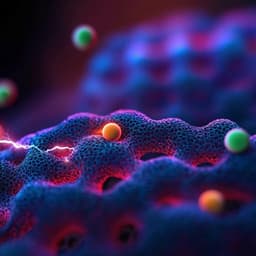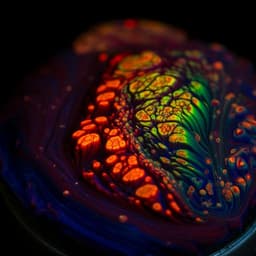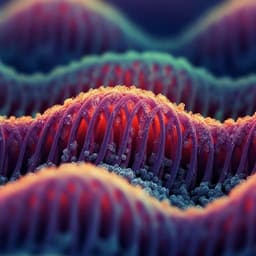
Chemistry
Elastic organic crystals with ultralong phosphorescence for flexible anti-counterfeiting
K. Huang, L. Song, et al.
This groundbreaking research introduces elastic organic crystals (EOCs) with ultralong organic phosphorescence (UOP), showcasing incredible elasticity and high phosphorescent efficiency. Developed by a team of researchers, these innovative materials hold great promise for flexible technologies and anti-counterfeiting applications.
~3 min • Beginner • English
Introduction
Flexible electronics is becoming an emerging research field with a rapid growth rate due to innovative applications in displays, electronic skin, and solar cells, which accelerate the course of flexible materials. Many flexible materials including metals, inorganic materials, 2D materials, and organics have been developed. Among them, organics show great promise in high-performance device applications owing to their extensive resource, tunable functions, and good processability. Flexible organic materials include polymers, liquid crystals, and organic crystals. Organic crystals especially display excellent performances owing to their ordered molecular packing, but weak intermolecular interactions usually result in rigidity and fragility. Elastic organic crystals (EOCs) have been realized recently via π–π stacking and multi-directional halogen or hydrogen bonds. The luminescent properties of EOCs are important for applications in flexible devices. To date, series of EOCs with short-lived luminescence (≤1 ms) have been developed, but there has been no report on flexible crystals with an afterglow feature (>100 ms), although afterglow materials show superiority in optoelectronics due to long-lived lifetimes.
Ultralong organic phosphorescence (UOP) has attracted increased attention due to long-lived lifetimes and rich excited-state properties. Different from inorganic and organometallic phosphors, purely organic luminescent materials with UOP features at room temperature are rare owing to the forbidden singlet-to-triplet transition and fast non-radiative decay of excitons. Strategies to obtain efficient phosphorescence include introducing carbonyl or halogen atoms to promote intersystem crossing (ISC) and constructing a rigid environment to suppress non-radiative transitions. Rigid environments can be achieved by crystallization, host–guest doping, self-assembly, and related methods. Inspired by the requirements of reversible crystal deformation and efficient UOP, the authors proposed that halogen atoms and π-conjugated phosphorescent chromophores are suitable structural units to construct elastic crystals, while high phosphorescence efficiency can be achieved by introducing halogens to increase ISC.
Literature Review
The paper reviews prior progress in flexible electronics and flexible materials (metals, inorganic, 2D materials, organics) and emphasizes the promise of organic materials in devices due to tunability and processability. Within organic flexible materials (polymers, liquid crystals, organic crystals), organic crystals offer high performance from ordered packing but typically suffer from brittleness due to weak intermolecular interactions. Elastic organic crystals have been achieved using π–π stacking and multi-directional halogen or hydrogen bonds, with several EOCs exhibiting only short-lived luminescence (≤1 ms). There had been no report of flexible crystals with persistent afterglow (>100 ms) despite the advantages of long-lived emission for optoelectronics. For achieving room-temperature UOP in purely organic systems, literature strategies include enhancing ISC via carbonyl or halogen substitutions and suppressing non-radiative decay by creating rigid environments through crystal engineering, host–guest doping, and self-assembly. This context motivates combining heavy-atom effects (halogens) with π-conjugated phosphorescent chromophores to realize elastic crystals with ultralong phosphorescence.
Methodology
- Molecular design and synthesis: Three carbazole–triazine-based molecules with para-halogenated phenoxy substituents were designed: DCz4Cl, DCz4Br, and DCz4I. They were synthesized via a two-step reaction (details in Supplementary Fig. 1). Structures were confirmed by 1H/13C NMR and single-crystal X-ray analysis; purity verified by HPLC and elemental analysis.
- Crystal growth: Needle-like single crystals (length 10–15 mm) were obtained by slow evaporation from dichloromethane/ethanol (4:1) at room temperature.
- Mechanical testing: Individual crystals were fixed at one end with silicone grease and bent by applying stress with a pin; bending–release cycles were recorded (Supplementary Movies 1–3). Elastic strain ε was estimated by ε = t/(2R), where t is crystal thickness and R the radius of curvature (values compiled in Supplementary Table 1).
- Photophysical characterization: UV–vis absorption and steady-state photoluminescence measured in dilute THF (1×10⁻⁵ mol L⁻¹) and crystalline states. Phosphorescence spectra and lifetimes were obtained under ambient conditions (298 K) using an Edinburgh FLSP920 system with appropriate excitation sources and delays (e.g., 8 ms). Phosphorescence quantum efficiencies (Φph) were measured with a Hamamatsu Absolute PL Quantum Yield Spectrometer. Excitation–phosphorescence mapping was conducted to distinguish delayed fluorescence from phosphorescence. Single-crystal lifetime measurements used a 360 nm UV laser with time-resolved CCD detection.
- Crystallography and packing analysis: Single-crystal structures were solved (Bruker SMART APEX-II, Mo Kα, 293 K). Attachment energy calculations (Materials Studio 7.0) determined crystal growth faces and bending planes.
- Theoretical calculations: Dimer interaction analyses and binding energies were calculated using DFT (Gaussian 09). Binding energies: B3LYP/6-31+G* (H, C, N, O) with SDD or LANL2DZ for halogens as appropriate. SOC constants between singlet and triplet states computed with the BDF program at B3LYP/GEN with DEF2-TZVP (H, C, N, O) and X2C-TZVPall (I). Reorganization energies and rates (kisc, krp) were derived from photophysical parameters and supporting formulas.
- Demonstration application: A DCz4I crystal was embedded beneath printed letters on a model flexible banknote. Emission under 365 nm UV illumination and afterglow upon lamp off were photographed both flat and bent to assess anti-counterfeiting performance and mechanical/optical robustness.
Key Findings
- All three compounds formed elastic organic crystals that could be bent into semicircles without breakage and recovered their shape repeatedly, demonstrating fatigueless elastic behavior. Estimated elastic strains: DCz4Cl, 3.99%; DCz4Br, 3.42%; DCz4I, 3.01% (all >3%, exceeding most reported EOCs).
- In crystals under 350 nm excitation, intense fluorescence (360–450 nm) and ultralong phosphorescence (~530 nm) were observed. Phosphorescence lifetimes (τ): DCz4Cl, 526 ms; DCz4Br, 307 ms; DCz4I, 268 ms. Lifetimes shortened after bending due to packing changes.
- Phosphorescence quantum efficiency (Φph) increased with halogen atomic mass: DCz4Cl, 0.54%; DCz4Br, 0.75%; DCz4I, 19.1% (DCz4I is ~34× DCz4Cl), yielding bright yellow afterglow visible to the eye.
- Excitation–emission mapping indicated delayed fluorescence contributions in DCz4Cl and DCz4Br, whereas DCz4I showed dominant phosphorescence (500–650 nm) without delayed fluorescence peaks.
- Structural origin of high Φph in DCz4I: dual C–I···π interactions (3.547 and 3.571 Å) versus single interactions in Cl/Br analogues; higher dimer binding energy for DCz4I (37.69 kJ mol⁻¹) vs C–H···Cl (12.43 kJ mol⁻¹) and C–H···Br (20.43 kJ mol⁻¹), enhancing heavy-atom effects and triplet harvesting.
- Calculated parameters support enhanced ISC and emission in DCz4I: larger SOC constant ξ(S1,T2) in DCz4I dimer (3.099 cm⁻¹) vs DCz4Cl (0.033 cm⁻¹) and DCz4Br (0.199 cm⁻¹); faster kisc and krp for DCz4I. Smaller reorganization energy in DCz4I indicates reduced structural relaxation and non-radiative deactivation.
- Elasticity mechanism: π–π stacking constructs molecular chains along the crystal a-axis; during bending, interchain distances expand/contract, modulating non-radiative rates and lifetimes. Multiple weak interactions (C–H···π at 2.881/2.893 Å; C–I···π at 3.547/3.571 Å; C–H···O) connect layers, acting as buffers to enable reversible bending without fracture.
- Application: A DCz4I crystal embedded in a flexible banknote produced strong blue fluorescence under UV and bright yellow afterglow penetrating the banknote after UV off. The crystal maintained persistent luminescence and elasticity when the banknote was bent and after multiple bending cycles, demonstrating anti-counterfeiting potential.
Discussion
The study addresses the lack of flexible organic crystals exhibiting persistent afterglow by combining heavy halogen atoms with π-conjugated phosphorescent chromophores and leveraging crystal engineering to create rigid yet elastically deformable environments. The iodine-containing DCz4I crystal exemplifies how strong halogen–π interactions and higher binding energies induce substantial heavy-atom effects, increasing SOC and ISC rates, thereby boosting triplet exciton formation and radiative decay from the triplet manifold. Simultaneously, the crystal packing—π–π chains with multi-directional weak interactions—provides mechanical compliance, enabling significant elastic strain without fracture. The observation that lifetimes decrease upon bending is consistent with transient packing perturbations that enhance non-radiative pathways, yet the crystals retain UOP and recover structurally, preserving functionality. These results validate the design hypothesis and demonstrate practical relevance through a banknote anti-counterfeiting prototype, where robust afterglow under deformation is critical. The work provides a blueprint for tailoring intermolecular interactions (halogen bonding, π–π stacking) to balance photophysical efficiency with mechanical elasticity in organic crystals for flexible optoelectronics.
Conclusion
The authors developed a series of elastic organic crystals (DCz4Cl, DCz4Br, DCz4I) exhibiting ultralong phosphorescence and substantial elastic strains (>3%). Among them, DCz4I achieved a high phosphorescence quantum efficiency of 19.1% with bright, long-lived afterglow under ambient conditions, attributed to dual C–I···π interactions, enhanced SOC and ISC, and favorable packing with multi-directional weak interactions that confer elasticity. A proof-of-concept anti-counterfeiting application embedded in a flexible banknote demonstrated durable optical and mechanical performance. This work establishes a generalizable strategy—introducing heavy halogens into π-conjugated phosphors and engineering crystal packing—to realize elastic afterglow crystals, expanding opportunities for flexible electronics and secure devices. Future research could explore broader molecular scaffolds, alternative heavy-atom or non-covalent interaction designs, optimization of emission color and lifetime, and integration into scalable flexible device architectures.
Limitations
The paper does not explicitly enumerate limitations. Noted observations include: (i) phosphorescence lifetimes become shorter after bending, indicating sensitivity of excited-state dynamics to packing perturbations; (ii) the study focuses on three halogen variants within a single molecular framework, so generality across other chemistries remains to be validated; (iii) the anti-counterfeiting demonstration is a proof-of-concept using single crystals rather than large-area or mass-produced components.
Related Publications
Explore these studies to deepen your understanding of the subject.







